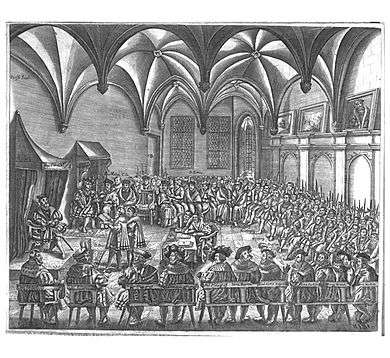Reservatum ecclesiasticum

The reservatum ecclesiasticum was a measure inserted into the Peace of Augsburg of 1555 to balance the principal proviso of cuius regio, eius religio in ecclesiastical lands. In the hereditary dynastic lands, such as those governed by a prince or a duke, the principle of cuius regio, eius religio (Latin: whose land, his religion) provided that the religion of the people would be the same as that of the territorial ruler.
If this same principle were applied in ecclesiastical lands, such as those ruled by a prince-bishop or an abbot, the conversion of an incumbent to Lutheranism would convert the entire principality to Protestantism. The reservatum ecclesiasticum was inserted to prevent this: in the event that the prince converted to Lutheranism, the ruler would forfeit his seat and be replaced by a Catholic. The measure was only inserted into the treaty as a result of Imperial authority, as it was not supported by Protestants participating in the treaty.[1] Nonetheless, the Protestants chose not to veto the measure and in return gained the Declaratio Ferdinandei that protected Protestant knights and long-established Protestant cities and communities, including those in territories where reservatum ecclesiasticum applied.[2]
| Date | 1555 |
|---|---|
| Location | Augsburg |
| Participants | Ferdinand, King of the Romans acting for Charles V. Delegates from the Imperial Estates |
| Outcome |
(1) The principle of cuius regio, eius religio established religious conformity within a single state. Two confessions of faith were acceptable: Catholicism or the Augsburg Confession (Lutheranism). Any other expression of faith was heretical. |
The measure was contested in 1583 when the Archbishop-Elector of Cologne, Gebhard Truchsess von Waldburg, converted to Protestantism, specifically to Calvinism. In the Cologne War, supported by the Dutch Republic and the Electorate of the Palatinate, he was eventually defeated by his Catholic replacement, Ernest of Bavaria, who was supported by his brother and Philip II of Spain, whose army, under the command of Alexander Farnese, Duke of Parma, physically recovered the electoral territory. Ernest's victory upheld the principle of the reservatum ecclesiasticum.
The measure continued to be a grievance of Protestants. After the ascension of Matthias as Holy Roman Emperor, his new chancellor Melchior Klesl hoped to dissolve the religious alliances of the time — the Protestant Union and the Catholic League — and bring people of all faiths back under the authority of the Emperor.[3] In response, the Protestant Union's Assembly at Rothenburg ob der Tauber voted in March 1613 to not disband while the Catholic League was still in existence, and to ensure certain long-standing grievances were rectified, including the reservatum ecclesiasticum.
See also
References
- ↑ Parker, Geoffrey. The Thirty Years' War, p. 17. ISBN 0-415-12883-8
- ↑ Joachim Whaley (2012) Germany and the Holy Roman Empire: Volume I: Maximilian I to the Peace of Westphalia, 1493-1648. ISBN 978-0-19-154752-2
- ↑ Parker, p. 30.